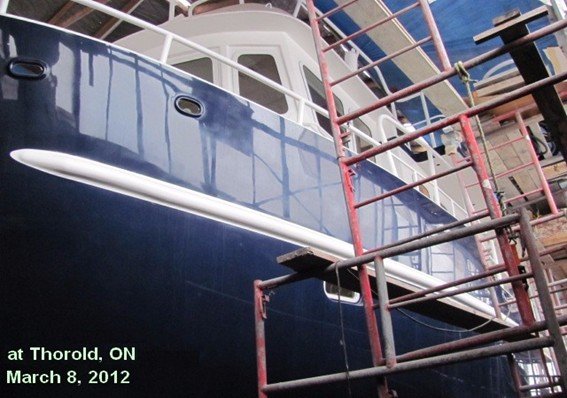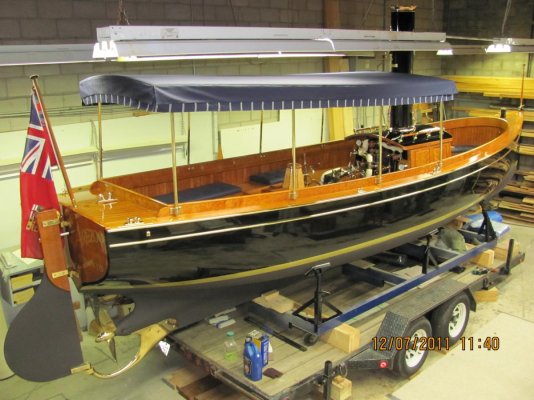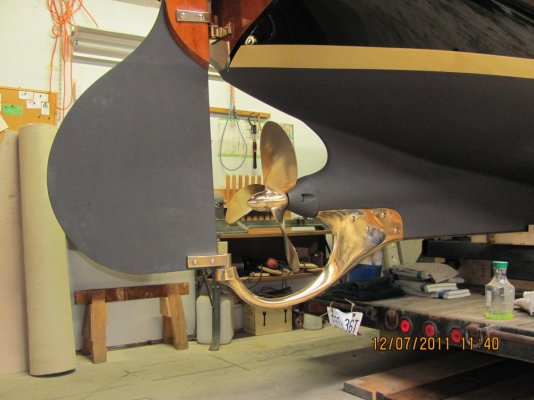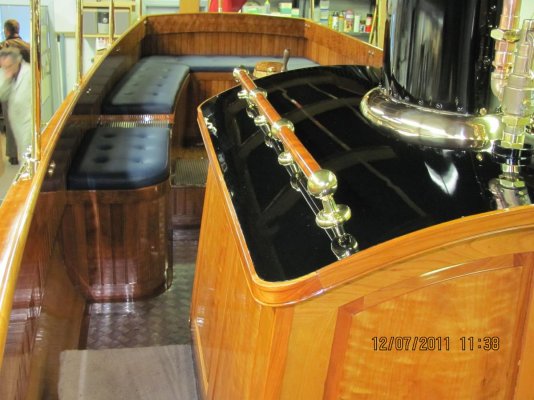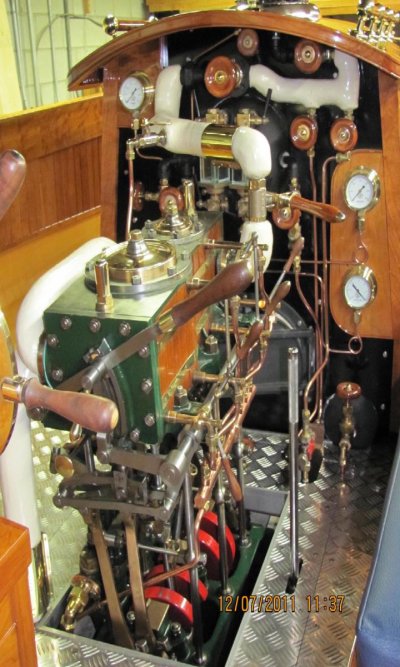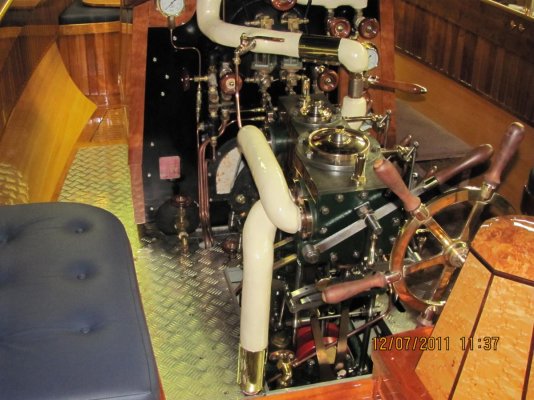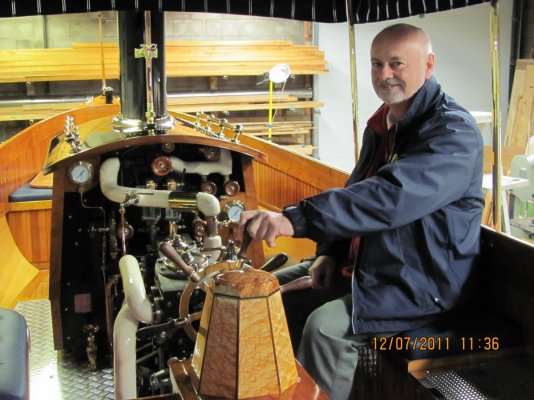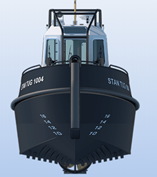Interesting article about that boat: http://www.findyachts.com/wp-content/uploads/Passagemaker-Sonata.pdfSome years ago we spent time with a very experienced world wide cruising couple who built a 62' steel Roberts design called "Sonata". Of the many nice things about her was a sound box enclosed JD 6081 engine. The build was done in their large farm yard in central CA.
You are using an out of date browser. It may not display this or other websites correctly.
You should upgrade or use an alternative browser.
You should upgrade or use an alternative browser.
Steel Trawlers - Pros and Cons
- Thread starter Capt. Kirk
- Start date
The friendliest place on the web for anyone who enjoys boating.
If you have answers, please help by responding to the unanswered posts.
If you have answers, please help by responding to the unanswered posts.
The “Romsdal” style with the bridge deck up there is pleasing to the eye and presumably has advantages in rough seas but it strikes me as harder to handle with one or two people, regardless of the hull material. Running back and forth and all.
That's correct I think, if you want to dock on your own. It’s 8 steps down from the wheelhouse, and out a door to the side deck on our boat.
For a crew of 2, it’s not that much different from a raised PH layout, as these boats are heavy and do not drift around that much. With large and slow turning props and large profiled rudders, you pin her to the dock for as long as the second hand needs to secure 2 lines.
Simi 60
Guru
- Joined
- Jul 1, 2016
- Messages
- 5,482
- Location
- Australia
- Vessel Make
- Milkraft 60 converted timber prawn trawler
That is cool, but too large (in my view) for an owner-operator.
.
For sure which is why she has been a look but don't touch BUT if I felt like running a business she'd be a great interisland trading vessel in Vanuatu , Solomans, PNG with cheap local crew but, I am always reminded of my short times there, setting up a smaller ex shark boat for a several times (now) failed businessman for exactly that and the often used saying .........
How do you make a small fortune in a 3rd world country?
Start off with a large one
This one is smaller but somewhat similar, and much more manageable:
https://www.yachtworld.com/boats/2002/washburn-doughty-expedition-yacht--3230961/
Had it been on the market before we bought out current boat, I might have jumped on a plane for an inspection
Yeah but its 6 x more money for a lot less boat
Last edited:
Simi 60
Guru
- Joined
- Jul 1, 2016
- Messages
- 5,482
- Location
- Australia
- Vessel Make
- Milkraft 60 converted timber prawn trawler
Honestly, I think for a couple in the sixties, a 60 feet trawler not exceeding 60 tons is certainly the maximum... I have both stern and bow hydraulics thrusters and a very efficient Dockmate remote control which let me free to jump on the pontoon. But you have to consider the ropes and their weight, and also,serious fenders necessar for an heavy trawler.
There is no many options:
- be younger and muscular!( I am 63..)
- be able to afford expenses of a crew
- if you can afford the crew, accept to live in "communauty" with this crew...
( certainly not guaranteed for me...)
- stay under 60 feet with a nice design ( wide body for example and fly bridge)
Well, we are not there (60's) yet but while I tend to agree that silly big could be hard, more from a maintenance viewpoint, I would have no issue with our layout on the bigger sister hull which is 5 ft longer and 4 ft more beam. She'd probably come in around 75 tonne. We are 65.
And it sounds like its only the docking that you think is the issue and I would agree
But bear in mind, if actually using the boat that can be a much lesser issue.
In over 4 years of full time cruising we dock no more than 2 x a year, no thrusters, no dockmate remote.
And now I have come across a bunkering service who comes out to us its even less.
Last edited:
A few pros for steel:
....
Most steel boats can withstand neglect and can be "brought back" if neglected
Judy
That point is very hard to agree with as a pro for steel compared to composite (perhaps more true compared to wood). An FRP boat can sit in a berth, or in mud, or on the hard without care for many decades without structural damage. In fact many of the very first FRP cruising boat are still in service, 70 years on. A steel one will need very extensive renovation after that period of neglect, if it isn't scrap. FRP boats are so durable it has literally ruined the boatbuilding industry.
WRT polishing and waxing, gel coat requires a lot of attention as it gets old. However many composite boats are painted, and painted with the same paint used on steel boats. The durability and care and the same, with the exception above: You can let the Awlgrip deteriorate on your FRP boat and then paint it 10 years late without much cost penalty and no structural worries. If you get scratches, repair them at your leisure. Not so true on steel.
David Ess
Scraping Paint
- Joined
- Dec 4, 2020
- Messages
- 392
DDW......It cant be much of a 'con' to worry about storing your boat for 70 years to most people, no matter what the hull material. Or, I could easily say that if I plan to keep my steel boat on the hard for some decades, Ill make sure it has proper modern coatings.
ddw36
Senior Member
- Joined
- Feb 28, 2019
- Messages
- 134
- Location
- USA
- Vessel Name
- HI-HO
- Vessel Make
- Diesel Duck 462 (my fantasy)
A beautiful boat, but the article was 14 yrs ago. How are the owners doing now? It seems there's so much automatic/electronic equipment that I'm wondering how that's working out.Interesting article about that boat: http://www.findyachts.com/wp-content/uploads/Passagemaker-Sonata.pdf
Hippocampus
Guru
- Joined
- Jul 27, 2020
- Messages
- 4,182
- Location
- Plymouth
- Vessel Name
- Hippocampus
- Vessel Make
- Nordic Tug 42
To the steelie owners. What coatings do you prefer? How would you go about assessing the integrity of the coatings at survey? What do you want to see on a steel boat? What kind of through hulls? What modifications to electrical systems? What should be stainless? What barrier is preferred between dissimilar metals? Aluminum port lights, deck fittings,, etc? We’ve been looking at diesel ducks. Any particular to those vessels we should be playing particular attention to?
klee wyck
Guru
- Joined
- Feb 8, 2014
- Messages
- 1,022
- Location
- USA PNW
- Vessel Name
- Domino and Libra
- Vessel Make
- Malcom Tennant 20M and Noordzee Kotter 52
To the steelie owners. What coatings do you prefer? How would you go about assessing the integrity of the coatings at survey? What do you want to see on a steel boat? What kind of through hulls? What modifications to electrical systems? What should be stainless? What barrier is preferred between dissimilar metals? Aluminum port lights, deck fittings,, etc? We’ve been looking at diesel ducks. Any particular to those vessels we should be playing particular attention to?
I am a steelie guy, but not an expert on coatings as someone like Delfin here or the Dutch builders. I expect this is a great question for them, but will give my experience and reasoning on the matter here anyway.
First, as expected, prep is likely more important than chemical. In the case of steel, the interval between prep and primer is also critical including the temperature and humidity conditions during the interval between prep and primer. In a perfect world, the interval between the blast and primer application should be as near zero as possible and the temp should be above 50 and humidity below 50. Good luck in the PNW in the offseason. Heated building or tent is the right way to do this. Once the first coat of primer is applied, the pressure is off a bit.
I will give you my materials list for my job last year on LIBRA below the waterline. There would be differences to the material and sequence above the waterline, obviously.
The blast spec I required was SSPC-SP-6 or better. This removes all visible oil, grease, dust, dirt, mill scale, rust, coating, oxides, corrosion products, and any other foreign matter on the surface.
Then, ASAP, apply PPG Dimetcote 302H zince primer. This is a proven cathodic primer for protecting steel.
Then two coats of PPG Amercoat 240 LH chosen as the epoxy barrier for its cooler weather cure performance and great edge wetting where it meets other coating borders.
Then just a coupe of coats of high quality bottom paint and we are off. I like Seahawk Sharkskin on these metal boats.
Up top it would be largely the same through epoxy but then lots of layers of something like Awlgrip or Alexseal.
The job below the waterline in 2020 was $32K. but should be good for at least twenty years.
In terms of judging coatings on a boat you might buy at a snapshot in time, not sure there is a good way to do this. I would inquire vigorously as to what is known for sure about the last application process and materials. After that, you need time to watch over time for developing bubbling or staining that indicates a less than professional job rather than just looking at survey time and trying to decide if it is a good job or not.
I have done KLEE WYCK below the waterline and parts of her house, but there are parts of her hull above the waterline that I have not touched during nine years of ownership that look like they are just freshly painted and that job was at least 15 years ago. The information I have suggests that that job was excellent prep and process, finished with twelve (12) coats of Awlgrip!
When done right, these boats always look really good with little care in terms of wash/wax/polish. We have owned LIBRA for four years and have washed her 4 times (always splash a rinse after cruise) and neve applied wax or polish. She looks decent all of the time.
With KLEE WYCK we rinse after cruise, wash once or twice a year, and do Finesse-it in the yard every 2 or three years when we do bottom. Blue hull always looks great. Folks often ask if she has just been painted.
FWIW
Simi 60
Guru
- Joined
- Jul 1, 2016
- Messages
- 5,482
- Location
- Australia
- Vessel Make
- Milkraft 60 converted timber prawn trawler
^^^^ Why would you go from using PPG Amercoat product to super expensive awlgrip ?
Doubt you'd ever see a commercial vessel painted with it and you can get equally as good result with product that has pictures of oilrigs and bulldozers on the label vs superyachts.
Doubt you'd ever see a commercial vessel painted with it and you can get equally as good result with product that has pictures of oilrigs and bulldozers on the label vs superyachts.
Hippocampus
Guru
- Joined
- Jul 27, 2020
- Messages
- 4,182
- Location
- Plymouth
- Vessel Name
- Hippocampus
- Vessel Make
- Nordic Tug 42
Great information. Thanks KW. Other question I have concerns stabilization. With the Canadian report I’m a little concerned about paravanes for stabilization. I’ve never seen standard fins on a steel boat and with the weight of steel construction gyros are a huge expense. A gyro was put in a Turkish DD. Must of been a >50k USD retrofit. Given the heavy displacement and hard chines of many steel trawlers is any form of stabilization really necessary? I know true trawlers are stabilized by the trawl but have seen long liners use paravanes. So for recreational steel FD trawlers what decision did you make about stabilization and why?
sunchaser
Guru
- Joined
- Apr 9, 2008
- Messages
- 10,292
- Location
- usa
- Vessel Name
- sunchaser V
- Vessel Make
- DeFever 48 (sold)
Great information. Thanks KW. Other question I have concerns stabilization. With the Canadian report I’m a little concerned about paravanes for stabilization. I’ve never seen standard fins on a steel boat and with the weight of steel construction gyros are a huge expense. A gyro was put in a Turkish DD. Must of been a >50k USD retrofit. Given the heavy displacement and hard chines of many steel trawlers is any form of stabilization really necessary? I know true trawlers are stabilized by the trawl but have seen long liners use paravanes. So for recreational steel FD trawlers what decision did you make about stabilization and why?
The penultimate steel Romsdal I've seen is owned by TF's Delfin. It has active stabilizers as I remember.
David Ess
Scraping Paint
- Joined
- Dec 4, 2020
- Messages
- 392
Hippocampus.....For many the cost of gyros like Seakeeper is not a concern since we see so many people buying them. Paravanes work well, but extra fussing about with them. Some like thoze huge bilge keels we recently saw here.
Judy at JWY
Senior Member
- Joined
- Oct 8, 2007
- Messages
- 217
The Cape Horn Trawlers that had active fin stabilizers were the 63s and the 81s. The fins were set inside the bilge keels. The fins were the only fiberglass component on the vessels. All other models relied on the bilge keels for passive stabilization.
Not all full displacement trawlers are inherently stable and many require additional stabilization via paravanes or active fin. A full displacement yacht should be inherently stable in its design and hull form.
Not all full displacement trawlers are inherently stable and many require additional stabilization via paravanes or active fin. A full displacement yacht should be inherently stable in its design and hull form.
Hippocampus
Guru
- Joined
- Jul 27, 2020
- Messages
- 4,182
- Location
- Plymouth
- Vessel Name
- Hippocampus
- Vessel Make
- Nordic Tug 42
My cursory understanding is all devices (gyros, fins & fish) improve ride but do nothing for AVS or safety in terms of ultimate stability or righting arm. So stability as meant by the rating agencies (ABS, DNV, Lloyd’s etc.) has a very different meaning than stabilization as used by pleasure boat makers and users. In fact fish can decrease righting arm increasing danger. Seakeeper says their current device can be used in heavy seas. My limited understanding is prior devices and some current ones in use are best turned off as they can decrease safety as well. So they’re all about comfort not AVS or Gz curves.
To the steelie owners.
What kind of through hulls?
All welded in steel pipes, and from the seacock onwards plumbed in plastic piping
What should be stainless?
All areas that might see chafing, like fairleads, bollards, rubbing strakes in polished 316
Other areas, like bow sections etc can be done a little less $$$ in 304 and painted
What barrier is preferred between dissimilar metals?
You can connect steel and alu, like hull and superstructure, with Triclad weld-in strips, proven for decades now
port lights, deck fittings,, etc?
Weld eveything on if available, or can be fabricated, in stainless 316 and polish, makes for least possible maintenace afterwards
Well, that's at least how it works for us
Great information. Thanks KW. Other question I have concerns stabilization. With the Canadian report I’m a little concerned about paravanes for stabilization. I’ve never seen standard fins on a steel boat and with the weight of steel construction gyros are a huge expense. A gyro was put in a Turkish DD. Must of been a >50k USD retrofit. Given the heavy displacement and hard chines of many steel trawlers is any form of stabilization really necessary? I know true trawlers are stabilized by the trawl but have seen long liners use paravanes. So for recreational steel FD trawlers what decision did you make about stabilization and why?
We have long but narrow bilge keels/rolling chocks and fin stabilizers on a very seakindly hull.
At seatrial on the North Sea in typical weather, we switched off stabilization to test performance on various courses. All safe and well - but some crew ran for the rails after 10 minutes.
[FONT="]In costal waters I would not worry much with a seakindly hull, but if heading offshore is on your to do list, I would still suggest some form of mechanical stabilization.
[/FONT]
Hippocampus
Guru
- Joined
- Jul 27, 2020
- Messages
- 4,182
- Location
- Plymouth
- Vessel Name
- Hippocampus
- Vessel Make
- Nordic Tug 42
W helpful post. Have seen marelon, seachests and true standpipes on metal boats. Any +/- between those choices? Diesel ducks seem to have fuel tanks that are untreated or painted inside. Seems they depend on splash of diesel while underway or immersion by diesel when completely full to prevent rust. Any opinions if this is adequate. Tanks create a double hull in effect on these vessels so would think replacement might be problematic.
David Ess
Scraping Paint
- Joined
- Dec 4, 2020
- Messages
- 392
Judy at JWY..........what did you think of the Seaton 64 expedition twrawler? I recently sent in a foto of one.
W helpful post. Have seen marelon, seachests and true standpipes on metal boats. Any +/- between those choices? Diesel ducks seem to have fuel tanks that are untreated or painted inside. Seems they depend on splash of diesel while underway or immersion by diesel when completely full to prevent rust. Any opinions if this is adequate. Tanks create a double hull in effect on these vessels so would think replacement might be problematic.
We have only one smallish through-hull for sea water with a standpipe and Vetus filter + plastic piping, everything else is on hull coolers. Works fine.
Diesel tanks are o.k. in untreated steel, freshwater only with a very good food-grade and professionally applied paint system.
Black and grey water tanks in PE only, no metal acceptable here for us.
My 65' Burger had a single 1600 gal fuel tank under the sole. It was completely sealed with no access panels. A single fill point. Although I don't know if there was any paint applied, because it was built in the 50's I assume it was just plain untreated steel, which was the norm back then. Relying on the "splash of oil" as was said above.
So 40 years later it was still in great shape. Never cleaned it out but I did use additives of course. But honestly I attribute its condition to the twin Jimmies, which are fuel polishers by nature.
So 40 years later it was still in great shape. Never cleaned it out but I did use additives of course. But honestly I attribute its condition to the twin Jimmies, which are fuel polishers by nature.
Yes, the same naval architect, Robert C. Johnston (Bob) who passed away about 2 years ago. Griffin is proof that a custom built yacht can be of excellent design and construction. However, when I listed Griffin on YachtWorld, I refused to call her "custom;" I tried using the architect's name in various forms (after all, YW allows for a Seaton moniker) and various other build names, but YW only allowed "custom" for this boat. And she was too fine a vessel for that denigration. Being the exclusive sales rep for Cape Horn, and having concluded 18 CH sales, I took the liberty of calling Griffin a Cape Horn. I stated explicitly in the listing that she was only being called a CH because they shared the same NA and YW wouldn't bend their rules just because they didn't recognize the yard where she was built nor the NA. I made sure every prospective client knew that and why I corrected it in the TF post above.
Judy
I surveyed that boat three times while under construction in a muddy field at the side of the Welland Canal. The original owner/builder was a fanatic perfectionist and a really nice guy, he even built that massive achor from scratch. Of thousands of boats surveyed, I have been impressed three times. All three were home built boats like this one which is a work of art.
I also was fortunate to receive some metal boat survey tutoring from Robert Johnstone (famous for his Maid of The Mist), a true salty character who had been known to design on paper napkins in a bar while having a beer.
Attachments
Judy at JWY
Senior Member
- Joined
- Oct 8, 2007
- Messages
- 217
Boatpoker - great post.
Was another one of your 3 beauties a Canadian built aluminum Diesel Duck? I have now revealed my 3 home-built favorites: the Bob Johnston "fire truck" boat, Griffin, and the Diesel Duck. I don't think I have a #4 on my list, but I am just now realizing that all 3 of these are aluminum.Whoops, this is the steel boat thread ;-)
Was another one of your 3 beauties a Canadian built aluminum Diesel Duck? I have now revealed my 3 home-built favorites: the Bob Johnston "fire truck" boat, Griffin, and the Diesel Duck. I don't think I have a #4 on my list, but I am just now realizing that all 3 of these are aluminum.Whoops, this is the steel boat thread ;-)
David Ess
Scraping Paint
- Joined
- Dec 4, 2020
- Messages
- 392
Boatpoker - great post.
Was another one of your 3 beauties a Canadian built aluminum Diesel Duck? I have now revealed my 3 home-built favorites: the Bob Johnston "fire truck" boat, Griffin, and the Diesel Duck. I don't think I have a #4 on my list, but I am just now realizing that all 3 of these are aluminum.Whoops, this is the steel boat thread ;-)
Best trawlers ive ever seen. I remember one of them even had a 3" thick steel skeg shoe!
Boatpoker - great post.
Was another one of your 3 beauties a Canadian built aluminum Diesel Duck? I have now revealed my 3 home-built favorites: the Bob Johnston "fire truck" boat, Griffin, and the Diesel Duck. I don't think I have a #4 on my list, but I am just now realizing that all 3 of these are aluminum.Whoops, this is the steel boat thread ;-)
One was a sailboat ... so really doesn't count
The other was this cold molded steamer where the owner built absolutely everything except the guages, the stuffing box and the propeller.
Attachments
Judy at JWY
Senior Member
- Joined
- Oct 8, 2007
- Messages
- 217
Best trawlers ive ever seen. I remember one of them even had a 3" thick steel skeg shoe!
Now we're back to the steel boats. Good memory. Cape Horn Trawlers have a steel 3" keel shoe.
Judy at JWY
Senior Member
- Joined
- Oct 8, 2007
- Messages
- 217
Boatpoker - thanks for showing us this beauty.
David Ess
Scraping Paint
- Joined
- Dec 4, 2020
- Messages
- 392
Now we're back to the steel boats. Good memory. Cape Horn Trawlers have a steel 3" keel shoe.
Thanks, and when I saw that 3" steel shoe I though thats more like it for slidong over coral or whales, etc. Does ANY other trawler have that?
David Ess
Scraping Paint
- Joined
- Dec 4, 2020
- Messages
- 392
That was added along with extra balast when the first one almost rolled over at launch.
Not sure if I believe that, the Cape Horn boats were designed to be self righting withinin seconds. I think the have 5 or more watertight compartments.
David Ess
Scraping Paint
- Joined
- Dec 4, 2020
- Messages
- 392
Tugboat hull question
What are the protubances at the bottom of the hull here? I couldnt download any better, or real photos, but they look like square strips from stem to stern, about 2 or more inches thick. I noticed them on the dutch Damen tugs, and there are some pics of them on their website.
What are the protubances at the bottom of the hull here? I couldnt download any better, or real photos, but they look like square strips from stem to stern, about 2 or more inches thick. I noticed them on the dutch Damen tugs, and there are some pics of them on their website.
Attachments
Similar threads
- Replies
- 10
- Views
- 630
- Replies
- 12
- Views
- 2K

